THANKSGIVING RECIPES
Classic Roast Turkey | Wild Rice Mushroom Stuffing | Healthy Turkey Gravy
QUICK AND EASY LEFTOVER TURKEY RECIPES
Turkey Curry | Turkey Barley Soup | Asian Turkey Slaw | Turkey Avocado Wrap | Turkey Chili | Cubed Turkey on Salads
Nutrition Know-How
Heritage vs. Factory-Farmed Turkeys
- Pasture-raised heritage turkeys are higher in omega-3 fatty acids than grain-fed turkeys raised in factory farms. They are also lower in pro-inflammatory omega-6 fatty acids.
- Pasture-raised heritage turkeys do not require the antibiotics and hormones necessary to raise turkeys under stressed, dirty, overcrowded conditions, keeping the meat cleaner and safer for you.
- Because factory-farmed turkeys tend to be dry and tasteless, they’re often injected with saline solution, vegetable oils and additives to enhance their taste — and you’re stuck paying for the extra weight.
- Turkeys processed by the farmer — as opposed to large processing facilities — are much less likely to be exposed to and contaminated with harmful bacteria.
- Turkeys, in general, are a great source of protein. They also contain high levels of vitamin B6, immune-boosting selenium and zinc, and energy-supporting phosphorous.
Kitchen Tricks
- Before cooking a turkey, remove the neck and giblets from the body cavity. Wash the turkey inside and out with cold water.
- Always wash your hands, utensils and cutting boards with warm, soapy water after handling raw turkey.
- If you do use a frozen turkey, never thaw it at room temperature. Instead, thaw it 24 hours for each 5 pounds in its original wrapper in the refrigerator. Or, place it wrapped in the sink, cover with cold water — and remember to keep refreshing the water! — and thaw 30 minutes per pound.
Shopping and Storage Tips
- To find heritage turkeys in your area, search www.localharvest.org and www.heritageturkeyfoundation.org. Pasture-raised turkeys (and other pasture-raised meats) can be found through www.eatwild.com. Whole Foods carries heritage birds, as do other natural food markets.
- If you want a pasture-raised heritage turkey, don’t delay. Many farmers sell out months in advance of Thanksgiving. If you’re thinking about purchasing a turkey directly from a farm, don’t hesitate to call the farmer and ask questions.
- Put fresh turkey in the refrigerator immediately and cook it within one to two days. If you do buy a frozen turkey, it can be frozen for up to a year.
- Once cooked, turkey, stuffing and gravy can be frozen. Eat within one month.
Recipes
Classic Roast Turkey

Directions
- Heat oven to 350 degrees F.
- Start with a pasture-raised heritage turkey. Wash and pat it dry. Season inside and out with salt, pepper, and fresh herbs like rosemary, sage and marjoram. Rub outside skin with butter.
- Place turkey breast-side down on a roasting rack; cook for 13 minutes per pound. Turn over halfway through roasting. (For a commercial-grocery-store turkey, roast for 20 minutes per pound, half of the time covered, half uncovered.) For safety, all poultry should be cooked to an internal temperature of 165 degrees F.
Wild Rice Mushroom Stuffing
With earthy ingredients like mushrooms, apples and wild rice, this is a richly flavored, gluten-free alternative to packaged bread-cube stuffing.
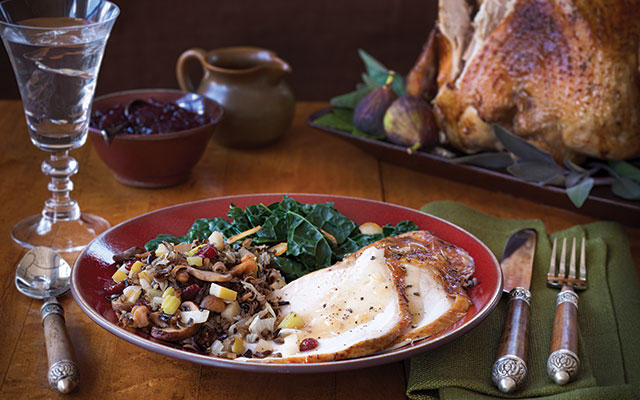
Makes 6 cups
Ingredients
- 8 ounces baby portabella mushrooms, sliced
- 2 tbs. butter
- 1 Granny Smith apple, diced
- 1/2 yellow onion, diced (about 1/2 cup)
- 2 stalks celery, diced (about 3/4 cup)
- 2 cups cooked wild rice
- 6 fresh sage leaves, minced
- 1/2 cup toasted, chopped walnuts
- 1/4 cup dried cranberries
- 1 cup hot turkey stock
- Salt and pepper to taste
Directions
- Sauté mushrooms in melted butter in a sauté pan until lightly browned. Add apples, onions and celery and sauté until tender.
- Mix wild rice, sage, walnuts and cranberries in a bowl, and stir in turkey stock to moisten.
- Season with salt and pepper.
- If you are planning to stuff the turkey cavity (the traditional approach), cool the stuffing first. To bake the stuffing separately (the current trend), lightly oil a baking dish and fill with stuffing. Lightly cover the stuffing with foil and bake at 350 degrees F for 15 minutes; remove foil and bake for another 10 minutes, until stuffing is slightly browned and heated through.
Light Turkey Gravy
Serve this delicate yet deeply flavorful gravy warm over sliced turkey, mashed potatoes — and all kinds of Thanksgiving leftovers.
Makes 2 cups
Ingredients
- 1 shallot, minced
- 1 tbs. butter
- 1/4 tsp. dried rubbed sage
- 1/4 tsp. dried rosemary leaves, crushed
- 1 tbs. potato starch
- 2 cups turkey stock and pan drippings
- 1/4 cup apple cider or cold water
- Salt and pepper to taste
- Fresh sage and rosemary (if desired, to garnish)
Directions
- In a small saucepan, sauté minced shallot in butter over low heat until caramelized, or light golden brown. Add dried sage and rosemary and sauté one minute. Mix in potato starch, then set aside.
- In a medium saucepan, combine stock and cider, and bring to a simmer. Stir the potato starch mixture into the simmering stock and stir until gravy is thickened.
- Season with salt and pepper according to taste. Garnish with fresh sage and rosemary.
Looking for more Thanksgiving recipe ideas? Visit “Your Thanksgiving Menu Planner“.
Quick and Easy Leftover Turkey Recipes
Turkey Curry
Leftover turkey makes an excellent curry dish, especially when served with brown rice. If you don’t have all these spices on hand, don’t be shy about buying them (most are available in small quantities in the bulk-spice section of natural markets). See the Ginger-Carrot Yogurt Sauce below for a yogurt sauce recipe to serve with this recipe and other curry dishes.
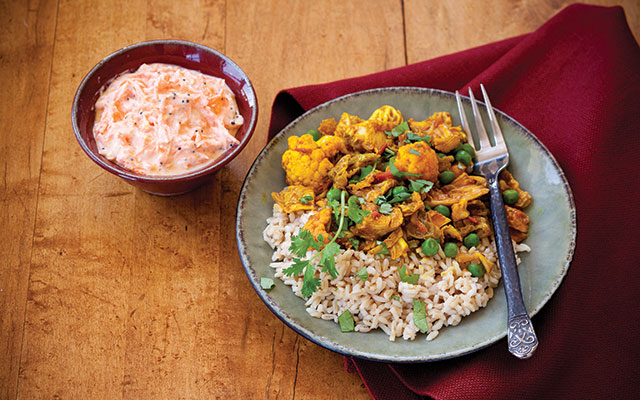
Makes 6 to 8 servings
Ingredients
- 1 tbs. coconut oil
- 1 medium yellow onion, diced (about 1 cup)
- 2 tbs. minced gingerroot
- 4 cloves garlic, minced
- 1 to 2 jalapeño peppers, minced
- 1 tbs. cumin seeds
- 1 tbs. ground coriander
- 2 tsp. ground turmeric
- 1/8 tsp. ground cloves
- 1/4 tsp. ground cardamom
- 1 cup diced tomato
- 4 cups small cauliflower florets 4 cups Savoy cabbage, cut into 1-inch-square pieces
- 2 cups turkey stock
- 1 1/2 cups pulled, cooked turkey meat
- 1 1/2 cups frozen peas
- Salt to taste
- Fresh cilantro, chopped
Directions
- In a large Dutch oven or saucepan, heat the coconut oil over medium heat. Add the onion, ginger, garlic, jalapeños and cumin seeds. Sauté about five minutes, while stirring, and then add the coriander, turmeric, cloves and cardamom. Stir while continuing to cook over low heat, about three to five minutes.
- Add tomato and stir while cooking over low heat for five to six minutes. Increase heat, add cauliflower and sauté for two to three minutes.
- Then add cabbage and sauté for one more minute. Add turkey stock and bring to a simmer.
- Add turkey meat and peas, and continue cooking to heat through.
- Season with salt to taste and garnish with cilantro.
Ginger-Carrot Yogurt Sauce
Makes 2 cups
Ingredient
- 2 cups grated carrot
- 1/4 tsp. salt
- 1 tsp. coconut oil or ghee/clarified butter
- 1 tsp. black mustard seeds or whole cumin seeds
- 2 tsp. grated fresh ginger root
- 1 cup plain Greek yogurt
Directions
- Place grated carrots in a bowl and toss with salt.
- Heat coconut oil in a small sauté pan and add black mustard seeds.
- Toast while stirring until they begin to “pop.” You may want to cover with a lid so the mustard seeds don’t fly out of the pan. Add seeds to the carrots, and stir in the ginger root and yogurt until mixed well.
- Store in the refrigerator until ready to serve.
Turkey Barley Soup
Homemade turkey stock is a great base and perhaps the most important part of this wholesome soup. With its whole barley, carrots, celery, onion, kale, and chopped fresh parsley and cubed turkey meat, you have truly nurturing soup.
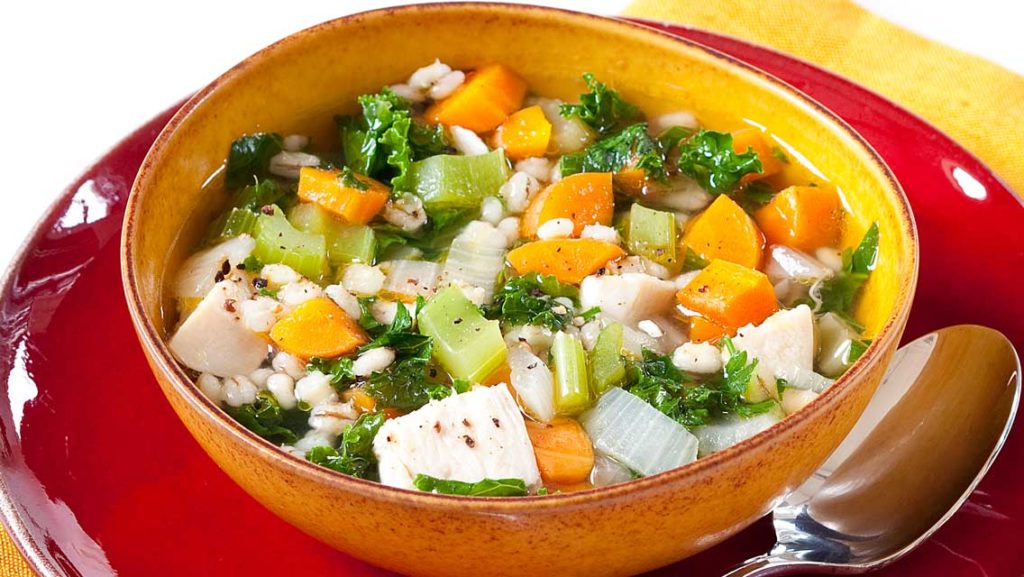
Makes 8 cups
Ingredients
- 1 tbs. olive oil
- 1 large onion, coarsely chopped diced (about 1 1/2 cups)
- 2 cups coarsely chopped celery, about 6 stalks
- 6 carrots, coarsely chopped (about 2 cups)0
- 1/2 cup hulled barley
- 6 cups turkey stock (homemade is best)
- 1 1/2 cups pulled turkey meat
- 2 cups coarsely chopped kale
- 1/2 cup coarsely chopped Italian parsley
- Salt and pepper to taste
Directions
- Heat olive oil in a large stockpot, sauté the onion for five minutes, and then add the carrots, celery and barley. Sauté while stirring for about five minutes and then add turkey stock and bring to a simmer.
- Cover the pot and let soup simmer until barley and vegetables are cooked through, about 20 to 25 minutes.
- Add the turkey meat, kale and parsley and season the soup with salt and pepper according to taste. Make sure to taste the broth, especially if it has been made from a brined turkey, since it will be a bit saltier than stock made from an unbrined turkey.
Asian Turkey Slaw
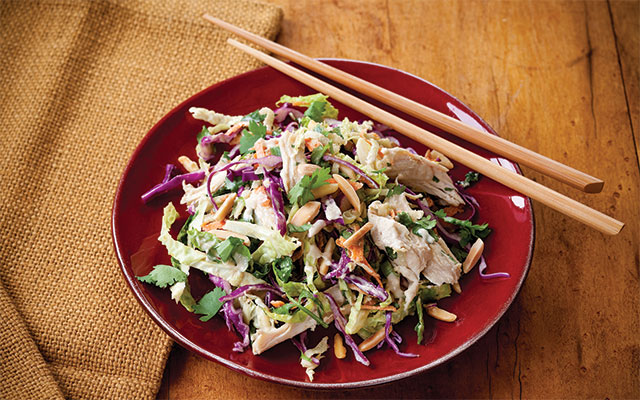
Mix shredded turkey into your favorite slaw mix. Simply toss with tahini dressing and sesame vinaigrette, then add green onions and toasted slivered almonds for crunch.
Turkey Avocado Wrap
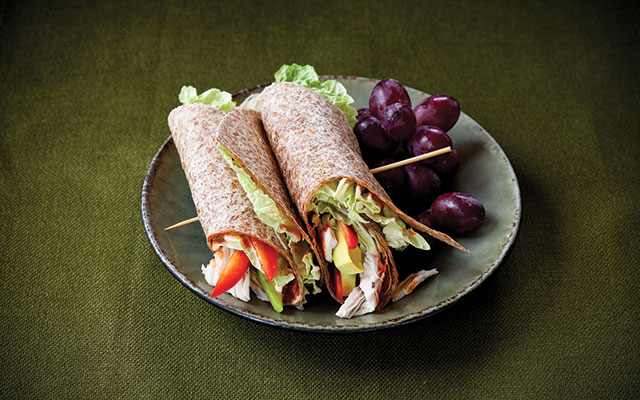
On a sprouted-grain wrap, spread cranberry mustard spread (equal parts Dijon mustard and cranberry sauce) or cranberry Thai chili spread (one part Thai chili sauce to three parts cranberry sauce). Add shredded Napa cabbage, sliced avocado (or try thin slices of cucumber with the Thai chili sauce), shredded turkey meat, and thinly sliced strips of red bell pepper. Roll up the wrap, and cut it in half diagonally.
Turkey Chili
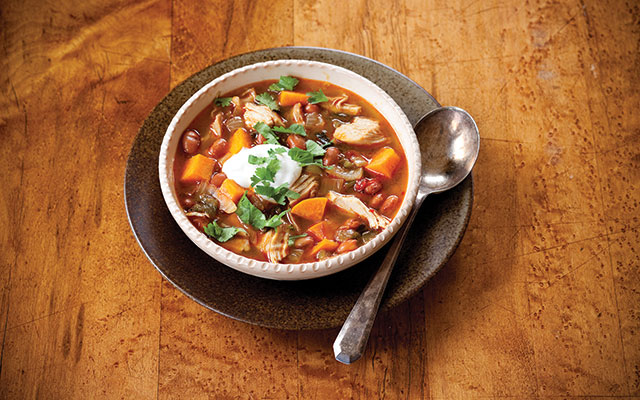
Mix up your favorite chili. In the last five minutes of cooking or reheating, toss in a hearty helping of chopped cooked turkey meat. Top with a dollop of tangy Greek yogurt and chopped green onion. Add a flourish of cayenne or red chili pepper for extra spice, and some fresh cilantro for color and scent.
Cubed Turkey on Salads
Top salads with leftover turkey and add your favorite seasonal ingredients, such as diced pear or apple, dried cranberries and toasted pecans. Bonus: Use up leftover cranberry sauce by making it into a quick vinaigrette: add 1 tablespoon red wine vinegar to 1/4 cup cranberry sauce, whisk in 1/4 cup olive oil, then add salt and black pepper to taste.
All of this issue’s recipes were created by Betsy Nelson — a.k.a. “That Food Girl” — a Minneapolis-based food stylist and recipe developer.
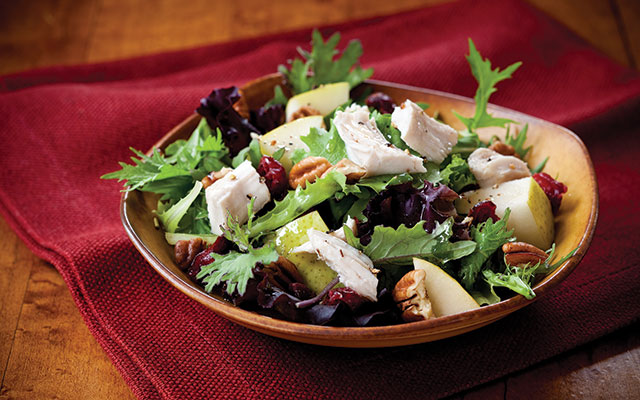

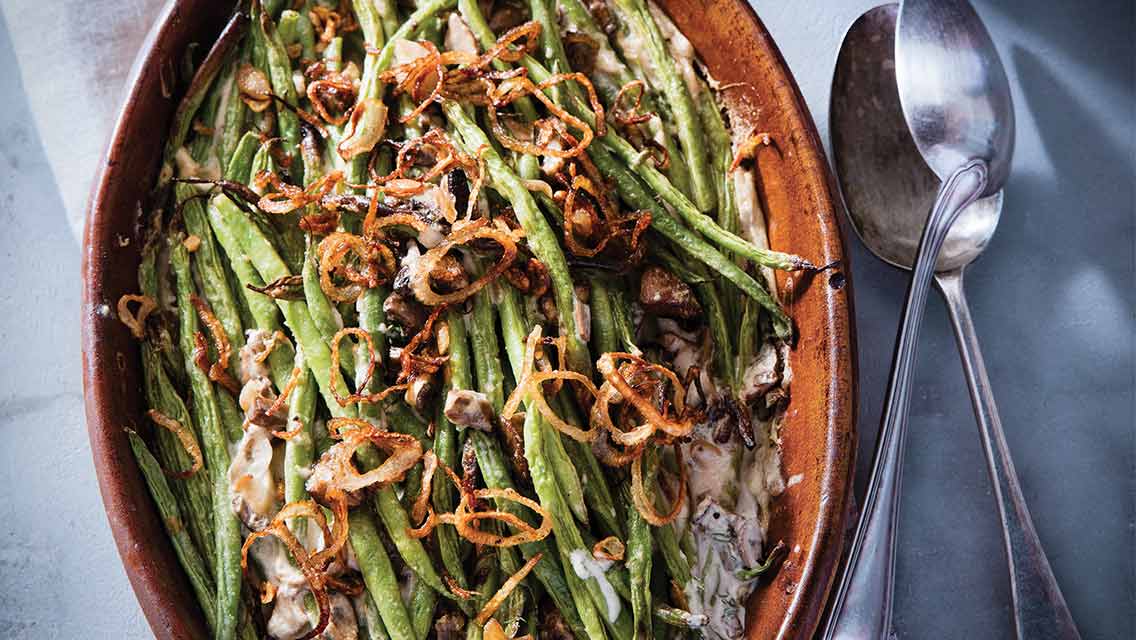
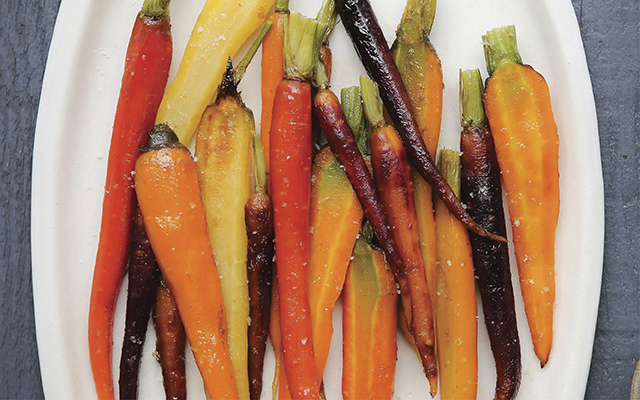
This Post Has 0 Comments